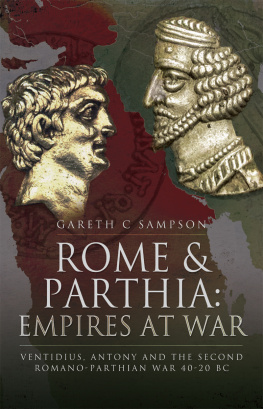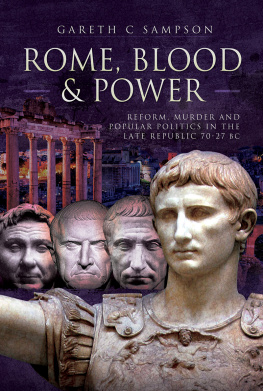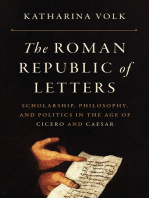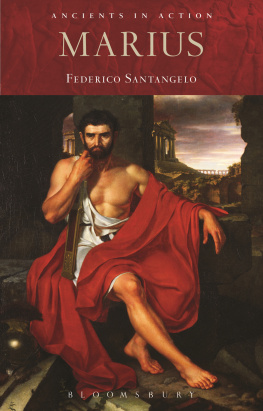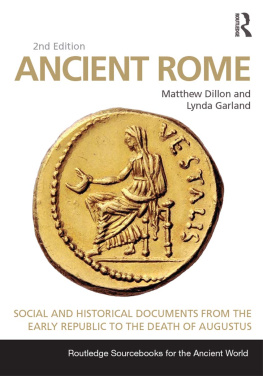Rome, Blood & Politics
Rome, Blood & Politics
Reform, Murder and Popular Politics in the Late Republic 13370 BC
Gareth C. Sampson
First published in Great Britain in 2017 by
Pen & Sword Military
an imprint of
Pen & Sword Books Ltd
47 Church Street
Barnsley
South Yorkshire
S70 2AS
Copyright Gareth C. Sampson, 2017
ISBN 978 1 47388 732 9
eISBN 978 1 47388 734 3
Mobi ISBN 978 1 47388 733 6
The right of Gareth C. Sampson to be identified as Author of this work has been asserted by him in accordance with the Copyright, Designs and Patents Act 1988.
A CIP catalogue record for this book is available from the British Library.
All rights reserved. No part of this book may be reproduced or transmitted in any form or by any means, electronic or mechanical including photocopying, recording or by any information storage and retrieval system, without permission from the Publisher in writing.
Pen & Sword Books Ltd incorporates the Imprints of Pen & Sword Archaeology, Atlas, Aviation, Battleground, Discovery, Family History, History, Maritime, Military, Naval, Politics, Railways, Select, Transport, True Crime, Fiction, Frontline Books, Leo Cooper, Praetorian Press, Seaforth Publishing, Wharncliffe and White Owl.
For a complete list of Pen & Sword titles please contact
PEN & SWORD BOOKS LIMITED
47 Church Street, Barnsley, South Yorkshire, S70 2AS, England
E-mail:
Website: www.pen-and-sword.co.uk
Dedication
As always this work is dedicated to my family: my wonderful wife Alex and my two gorgeous children, Thomas and Caitlin.
Contents
Acknowledgements
The greatest acknowledgement goes to my wife Alex, without whose support none of these books would ever be written. Special mention must be made to the kids, Thomas and Caitlin, who inspire me to write in short but intense bursts. As always, a lifelong debt of gratitude goes out to my parents, who have always supported me and encouraged my love of learning.
There are a number of individuals who through the years have inspired the love of Roman history in me and mentored me along the way: Michael Gracey at William Hulme, David Shotter at Lancaster and Tim Cornell at Manchester. My heartfelt thanks go out to them all.
Special mention must go to my editor Phil Sidnell, whose patience is legendary and usually needed when Im writing a book.
Maps
Map 1: The Mediterranean World in 146 BC.
Map 2: The Mediterranean World in 86 BC.
Map 3: The Mediterranean World in 8382 BC.
Map 4: The Mediterranean World in 70 BC.
Map 1: The Mediterranean World in 146 BC.
Map 2: The Mediterranean World in 86 BC.
Map 3: The Mediterranean World in 8382 BC.
Map 4: The Mediterranean World in 70 BC.
Introduction
From Conquest to Collapse
The year 146 BC marks a watershed in the history of the ancient world, as it saw the bloody conclusion of two wars; one was in North Africa and one was in Greece, and both involved the Roman Republic. In military terms the wars were both one-sided affairs, with the might of the Roman Republic facing a weakened Carthage in North Africa and an exhausted Macedon and Achaean League in Greece. Two of the greatest powers of the ancient world, Carthage and Macedon (whose power had already been shattered by Rome in a previous generation), were both annexed, becoming provinces of Romes burgeoning empire. Furthermore, Rome marked this very obvious dawning of a new era with the gratuitous destruction of two of the ancient worlds oldest cities, Carthage and Corinth, both sacrificed as a demonstration of what happens to those who opposed the will of the Senate and People of Rome.
Yet from this commanding position as unquestioned overlord of the Mediterranean world, within just over a decade the Republic saw a string of political murders and bloodletting in the very heart of Rome itself. Each decade that followed saw an escalation of the violence and bloodshed until the whole Republic collapsed into civil war and state-sponsored massacres. This period has always fascinated historians, from contemporary times to today. How could a seemingly invincible military power such as Rome cave in, in such a manner? The answer lay not in external enemies but from within Roman society itself and centred on Roman politics.
Roman Republican politics, like Roman society itself, was always a combative process, with an ever-changing group of political families vying for temporary pre-eminence and the chance of personal and family glory. Yet this centuries old system had always been able to accommodate and reconcile this race for personal and family glory with the collective good of the state (the res publica ). What is evident from the decades which followed 146 BC is the breakdown of this systems ability to reconcile these two opposing forces without resorting to bloodshed.
A series of Roman politicians (both high and low born) rose to prominence, all pushing foreword certain proposals for political, social or economic reform, many of which ended in spontaneous outbursts of political violence. This process fed on itself, with more radical proposals being made to settle this escalation of violence and bloodshed, with the political elites of Rome finding themselves seemingly locked in an ever-deteriorating cycle of reform and blood. This cycle reached such a point that it became perfectly logical (to certain Romans) to march a Roman army against Rome itself and institute a programme of state sponsored murder, all to save Rome and restore the res publica .
This is a study of both the evolution, and ultimately the failure of a political system and the key men who influenced it. It can be read in conjunction with my other works on the military campaigns of the period. Here we shall be examining some of the most famous figures in Roman history, from the Gracchan brothers who were murdered for advancing political reform through to Marius, the Italian outsider who became Romes greatest hero and then villain, to Sulla, who conquered and remoulded his own state to restore order, to the young men who grew up in a period of bloodshed: Pompeius, Crassus and Caesar.
Central to this study is a unique political office, the Tribunate of the Plebeian Order, which evolved from humble origins as the mouthpiece of a disenfranchised section of the Roman populace to being the most powerful, and most dangerous, political office in the Roman Republican system. The origins of this work lay in my doctoral thesis in the early twenty-first century: A re-examination of the office of the Tribunate of the Plebs in the Roman Republic (49423 BC) , whose dry title concealed an analysis of what lay behind five centuries of political clashes and bloodshed, at the very heart of the Roman Republican system.


